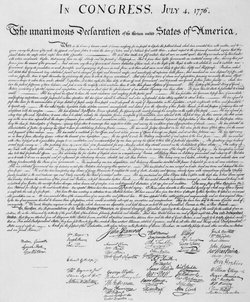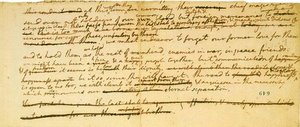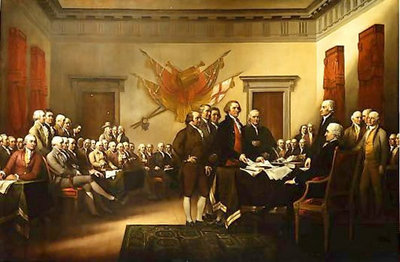|

Wikipedia - The
Declaration of Independence
The Declaration
of Independence is a document in which the Thirteen
Colonies declared themselves independent of the Kingdom
of Great Britain and explained their justifications for
doing so. It was ratified by the Continental
Congress on July
4, 1776;
this anniversary is celebrated as Independence
Day in the United
States. A signed copy is on display to the public in the National
Archives in Washington,
DC. The independence of the American colonies was recognized
by Great Britain on September
3, 1783,
by the Treaty
of Paris.

Background
Throughout the 1760s
and 1770s,
relations between Great Britain and thirteen of her North
American colonies had become increasingly strained. Fighting
broke out in 1775
at Lexington
and Concord marking the beginning of the American
Revolutionary War. Although there was little initial
sentiment for outright independence, the pamphlet Common
Sense by Thomas
Paine was able to promote the belief that total independence
was the only possible route for the colonies.
Independence was
adopted on July
2, 1776
pursuant to the "Lee Resolution" presented to the Continental
Congress by Richard
Henry Lee of Virginia
on June
7, 1776, which read (in part): "Resolved: That these
United Colonies are, and of right ought to be, free and
independent States, that they are absolved from all allegiance
to the British Crown, and that all political connection between
them and the State of Great Britain is, and ought to be, totally
dissolved."
On June
11, 1776, a committee consisting of John
Adams of Massachusetts,Benjamin
Franklin of Pennsylvania,Thomas
Jefferson of Virginia,Robert
R. Livingston of New
York, and Roger
Sherman of Connecticut,
was formed to draft a suitable declaration to frame this
resolution. Jefferson did most of the writing, with input from
the committee. His original draft included a denunciation of the
slave trade, which was later edited out. His draft was presented
to the Continental Congress on July
1, 1776. The Declaration was rewritten somewhat in general
session prior to its adoption by the Continental Congress on July
4, 1776, at the Pennsylvania
State House. The adopted copy was then sent a few blocks
away to the printing shop of John
Dunlap. Through the night between 150 and 200 copies were
made, now known as "Dunlap
broadsides". The original has never been found. The
25 Dunlap broadsides still known to exist are the oldest
surviving copies of the document.
The Declaration

The Declaration is
divided into three main sections: a preamble,
a list of grievances, and a conclusion. The preamble, the most
celebrated part of the document, states that whenever a people
decide to revolt, they are obligated to "declare the causes
which impel them to the separation." It is mainly a
sequential argument
in support of the revolution:
1. All men
are created equal
2. They are guaranteed by God
a set of unalienablerights
3. Governments
are established to safeguard these rights, and derive their just
power from the consent of the governed
4. Whenever a government neglects its duties, the
people have a right to change or abolish it and form a new
government that will guarantee their safety and happiness
5. Long-established governments should not be overthrown
for trivial reasons
6. However, repeated crimes and abuses require that the people
revolt
7. Such has been the case with Great
Britain
The Declaration
then backs up its argument with a long list of grievances
against the King
and his actions. There are some historians that claim that many
of the complaints are exagerrated propaganda,
but that overall they are an accurate portrayal of royal crimes.
Once the King's guilt is sufficiently proven, the document
concludes with a statement on British-American relationships, a
formal declaration
of America's independence and powers as a sovereign nation, and
a pledge by the signers to support the Declaration with their
"Lives," "Fortunes," and "sacred
Honor."
On July
19, 1776, Congress ordered a copy be handwritten for the
delegates to sign. This copy of the Declaration was produced by Timothy
Matlack, assistant to the secretary of Congress. Most of
the delegates signed it on August
2, 1776, in geographic order of their colonies from north to
south, though some delegates were not present and had to sign
later. Two delegates never signed at all. As new delegates
joined the congress, they were also allowed to sign. A total of
56 delegates eventually signed. This is the copy on display at
the National Archives. Word of the declaration reached London on
August
10.
Several myths
surround the document: because it is dated July 4, 1776,
many people falsely believe it was signed on that date. John
Hancock's name is larger than that of the other signatories,
and an unfounded legend states that it is large so that King George
III would be able to read it without his spectacles. A
painting by John
Trumbull, depicting the signing of the Declaration with all
representatives present, hangs in the grand Rotunda of the
Capitol of the United States: no such ceremony ever took place.
There is no evidence that Benjamin
Franklin ever made the statement often attributed to him:
"We must all hang together, or most assuredly we shall hang
separately". The Liberty
Bell was not rung to celebrate independence, and it
certainly did not acquire its crack on so doing: that story
comes from a children's book of fiction, Legends of the
American Revolution, by George Lippard. The Liberty Bell
was actually named in the early nineteenth century when it
became a symbol of the anti-slavery
movement.
A fictionalized
(but somewhat historically accurate) version of how the
Declaration came about is the musical play (and 1972
movie) 1776,
which is usually termed a "musical comedy" but deals
frankly with the political issues, especially how disagreement
over the institution of slavery almost defeated the
Declaration's adoption.
Some historians
believe that the Declaration was used as a propaganda
tool, in which the Americans tried to establish clear reasons
for their rebellion that might persuade reluctant colonists to
join them and establish their just cause to foreign governments
that might lend them aid. The Declaration also served to unite
the members of the Continental Congress. Most were aware that
they were signing what would be their death warrant in case the
Revolution failed, and the Declaration served to make anything
short of victory in the Revolution unthinkable.
The Declaration
appeals strongly to the concept of natural
law and self-determination.
The Declaration is heavily influenced by the Act of Abjuration
of the Dutch Republic and by the Discourses of Algernon
Sydney, to whose legacy Jefferson and Adams were equally
devoted. Ideas and even some of the phrasing was taken directly
from the writings of John
Locke, particularly his second treatise on government,
titled "Essay Concerning the true original, extent, and end
of Civil Government."
The Declaration of
Independence contains many of the founding fathers' fundamental
principles, some of which were later codified in the United
States Constitution. It has also been used as the model of a
number of later documents such as the declarations of
independence of Vietnam
and Rhodesia.
Inalienable vs.
unalienable
"Inalienable",
etymologically, comes from the French word inaliénable,
and is more usually used in legal documents than
"unalienable."
The idea of
inalienable rights, in almost the exact phrasing used in the
Declaration of Independence, came from the political philosopher
John
Locke. The Declaration of Independence was to a large degree
inspired by his work "The Second Treatise of
Government". In this treatise, Locke developed the
important idea of government by consent. Locke wrote that human
beings had certain inalienable rights.
Thomas Jefferson
originally wrote "inalienable". When subsequent
printed and hand-copied reproductions were made, John
Adams, fellow Declaration Committee member (and later second
President of the United States), arbitrarily had the word
changed to "unalienable"; which he believed more
correct. The original signed version of the final draft (i.e.
the master document) of the Declaration of Independence and the
inscription on the Jefferson Memorial both read
"inalienable". However, the copy in the National
Archives reads "unalienable".
Text of the
Declaration
The Preamble:
When in the
Course of human events, it becomes necessary for one people to
dissolve the political bands which have connected them with
another, and to assume among the powers of the earth, the
separate and equal station to which the Laws of Nature and of
Nature's God entitle them, a decent respect to the opinions of
mankind requires that they should declare the causes which impel
them to the separation.
We hold these
truths to be self-evident, that all men are created equal, that
they are endowed by their Creator with certain inalienable
Rights, that among these are Life, Liberty and the pursuit of
Happiness. -- That to secure these rights, Governments are
instituted among Men, deriving their just powers from the
consent of the governed, -- That whenever any Form of Government
becomes destructive of these ends, it is the Right of the People
to alter or to abolish it, and to institute new Government,
laying its foundation on such principles and organizing its
powers in such form, as to them shall seem most likely to effect
their Safety and Happiness. Prudence, indeed, will dictate that
Governments long established should not be changed for light and
transient causes; and accordingly all experience hath shewn,
that mankind are more disposed to suffer, while evils are
sufferable, than to right themselves by abolishing the forms to
which they are accustomed. But when a long train of abuses and
usurpations, pursuing invariably the same Object evinces a
design to reduce them under absolute Despotism, it is their
right, it is their duty, to throw off such Government, and to
provide new Guards for their future security. -- Such has been
the patient sufferance of these Colonies; and such is now the
necessity which constrains them to alter their former Systems of
Government. The history of the present King of Great Britain is
a history of repeated injuries and usurpations, all having in
direct object the establishment of an absolute Tyranny over
these States. To prove this, let Facts be submitted to a candid
world.
[List of charges
against the King follows]
The conclusion and
formal declaration: We, therefore, the Representatives of
the united States of America, in General Congress, Assembled,
appealing to the Supreme Judge of the world for the rectitude of
our intentions, do, in the Name, and by the Authority of the
good People of these Colonies, solemnly publish and declare,
That these United Colonies are, and of Right ought to be Free
and Independent States; that they are Absolved from all
Allegiance to the British Crown, and that all political
connection between them and the State of Great Britain, is and
ought to be totally dissolved; and that as Free and Independent
States, they have full Power to levy War, conclude Peace,
contract Alliances, establish Commerce, and to do all other Acts
and Things which Independent States may of right do. And for the
support of this Declaration, with a firm reliance on the
Protection of Divine Providence, we mutually pledge to each
other our Lives, our Fortunes and our sacred Honor.
Signers of the
Declaration

The signers of the
Declaration represented the new states as follows:
New
Hampshire:
Massachusetts:
Rhode
Island:
Connecticut:
New
York:
New
Jersey:
Pennsylvania:
Delaware:
Maryland:
Virginia:
North
Carolina:
South
Carolina:
Georgia:
External links
-
National
Archives Declaration of Independence Page
(http://www.nara.gov/exhall/charters/declaration/decmain.html)
-
The
Declaration of Independence: A History
(http://www.archives.gov/national_archives_experience/charters/declaration_history.html)
A National Archives page detailing the history of the
physical document from conception to today.
-
The
Stylistic Artistry of the Declaration of Independence
(http://www.archives.gov/national_archives_experience/charters/declaration_style.html)
By Stephen E. Lucas - A thorough linguistic examination of
the document.
-
"Drafting
of the Declaration of Independence. The Committee:
Franklin, Jefferson, Adams, Livingston, and Sherman."
1776. Copy of engraving after Alonzo Chappel. - credits
National Archives and Records Administration
(http://teachpol.tcnj.edu/amer_pol_hist/thumbnail31.html)
-- large
version (http://teachpol.tcnj.edu/amer_pol_hist/fi/0000001f.htm)
-
Mural
of the Declaration of Independence by John Trumbull
(http://teachpol.tcnj.edu/amer_pol_hist/thumbnail32.html)
-- *large
version (http://teachpol.tcnj.edu/amer_pol_hist/fi/00000020.htm)
-
Teaching
about the Declaration of Independence
(http://ericdigests.org/2003-4/independence.html)
-
Video
of Declaration of Independence being read
(http://www.declareyourself.com/videos.htm)
by Mel
Gibson, Michael
Douglas, Kevin
Spacey, Whoopi
Goldberg, Edward
Norton, Benicio
Del Toro, Renee
Zellweger, Winona
Ryder, Graham
Greene (actor), Ming-Na,
and Kathy
Bates. Introduction is by Morgan
Freeman.
-
U.S.
Independence celebrated on the wrong day? - National
Geographic (http://news.nationalgeographic.com/news/2004/06/0629_040629_july4.html)
-
Download
High-resolution images of Declaration
(http://www.archives.gov/national_archives_experience/charters/charters_downloads.html)From
the National Archives
Mentioned In
united states
declaration independence is mentioned in the following
topics:
|

